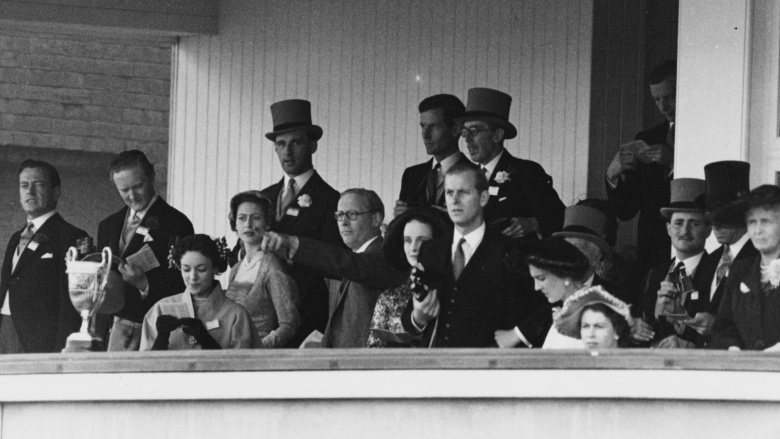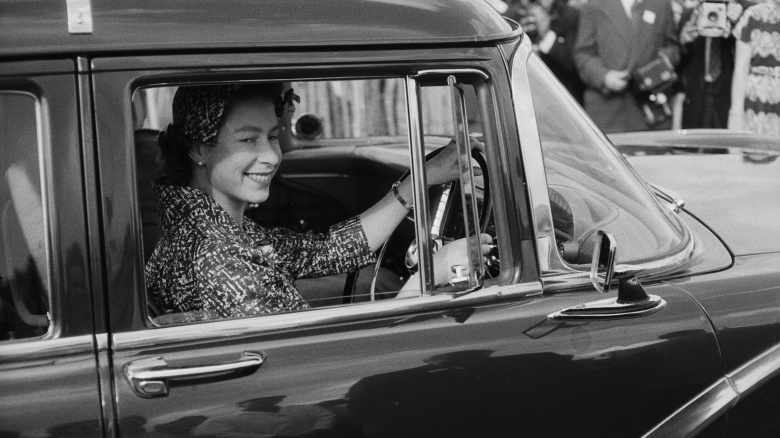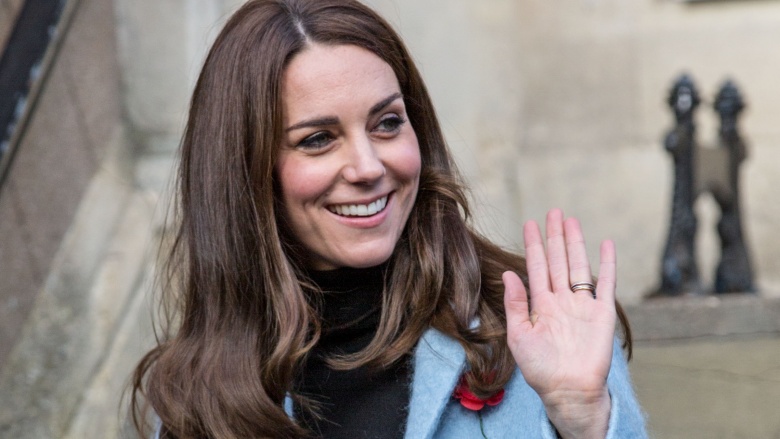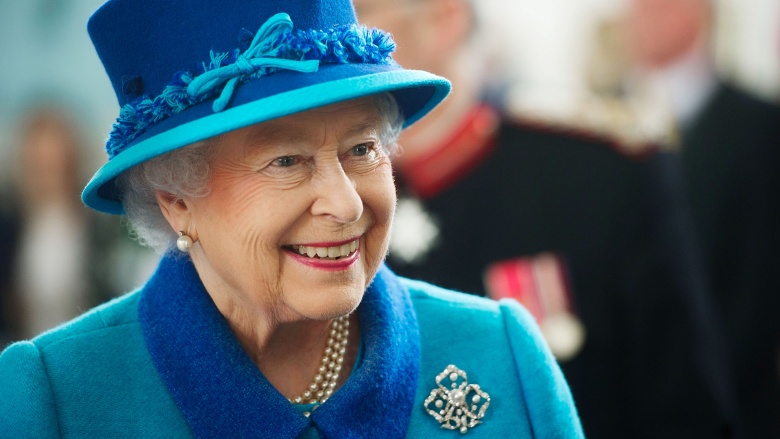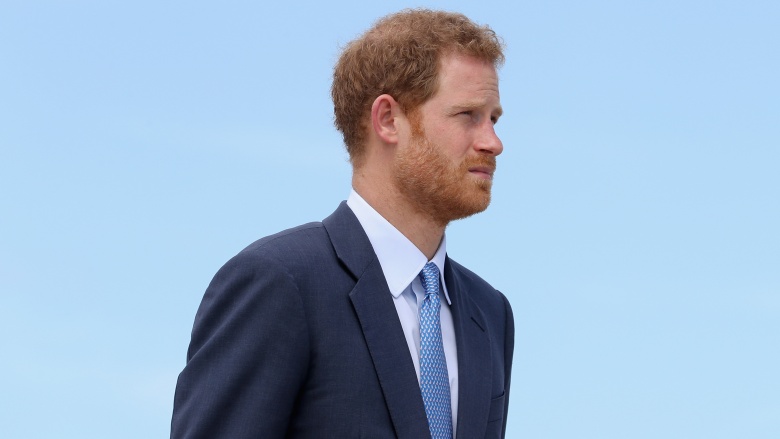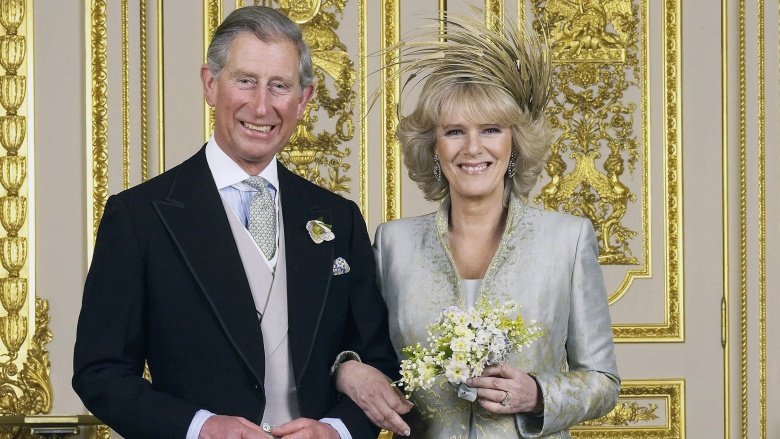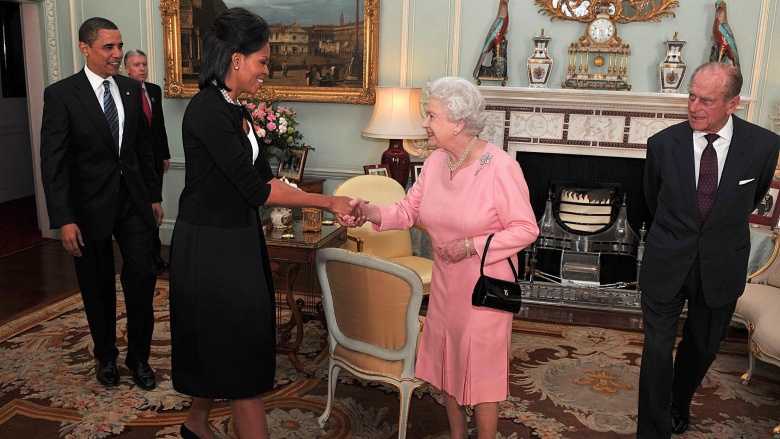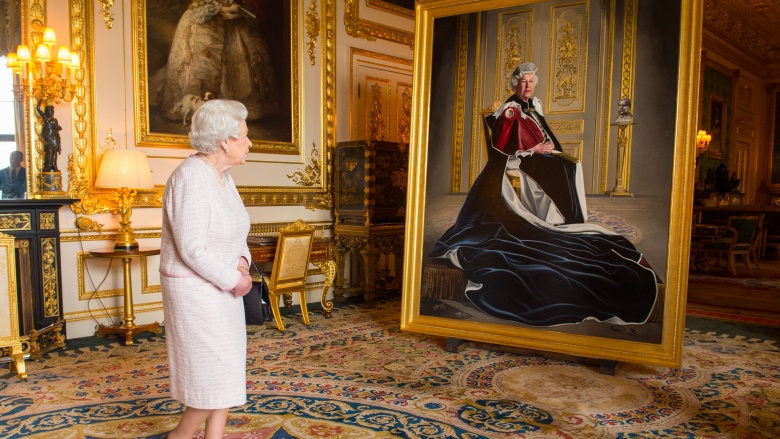False Facts About The Royal Family You Always Thought Were True
Regardless of where in the world you live, there's something fascinating about Britain's Royal Family. They're a reminder of a legacy that has lasted generations, persisting throughout centuries and culminating in what we see today. We see, too, how it's going to continue, and it's that massive legacy that captures the world's attention. For all the publicity that surrounds every moment of the lives of the Royal Family, there are some things we think we know... but absolutely don't.
The Queen forbid her sister to marry her first true love
The story is one that's been recently popularized in Netflix's drama The Crown, and it's the tale of a royal princess refused the right to marry a divorced airman. According to the version popularly told, Princess Margaret fell in love with Captain Peter Townsend, pilot from the Battle of Britain and equerry to both King George VI and Elizabeth II. The problem was that he was divorced, and to marry him would have been a major scandal in the eyes of the royals and the Church of England. Elizabeth II is said to have put her foot down and forbid the marriage, not only not giving the permission required (as dictated by the Royal Marriages Act of 1772), but telling her that if she disobeyed, she would find herself an exile no longer part of the family.
The truth, though, is even more complicated.
At the time, the Prime Minister was a man named Anthony Eden. He, too, had been divorced, and he amended the act so that Margaret's marriage to Townsend wouldn't remove her (or her children) from the line of succession at all. Elizabeth II agreed to the change, and Eden would write in at least one letter to his ministers that the queen had no desire to keep her sister from what would make her truly happy. The official documents that would have allowed the marriage are in the National Archives, and they've been publicly accessible since 2004. It wasn't until 2009 that a letter from Margaret to Eden revealed her own doubts as to whether or not she truly loved him. In it, she tells Eden that she plans on deciding in the upcoming months whether or not she was going to marry Townsend, and it's a letter that makes it clear Margaret was the one who made the decision based on her own feelings, not based on threats of being ostracized from the royal family.
The Queen doesn't need a passport because she's the Queen
It's true that Elizabeth II doesn't need a passport (or a driver's license), but not for the reason most people think. Most assume it's just because she's the Queen, and who's going to pull her over and ask for identification... or give her a ticket?
There's another sort of reasoning behind her not needing either document, and it's that they're all issued in her name. A British passport reads: "Her Britannic Majesty's Secretary of State requests and requires in the name of Her Majesty all those whom it may concern to allow the bearer to pass freely without let or hindrance and to afford the bearer such assistance and protection as may be necessary."
Since she's the one giving her protection out to passport holders, it's completely redundant for her to have one for herself. That's why she's the only member of the Royal Family to get away with not having one (everyone else needs her authority to travel). It's the same thing with the driver's license: they're issued under her authority, so she doesn't need to give herself one — she technically gives herself authority all the time. Since she doesn't have a license, she doesn't need registration or tags on her car, either.
Her name isn't actually Kate Middleton
Even those that don't follow the Royal Family know that Prince William married Kate Middleton. The name is all over the internet and magazine covers as far as you can see, but her name actually isn't Kate Middleton. Not anymore, at least. There are a few different ways she should be referred to, and the mainstream media is stubbornly adhering to the one she had when we first met her.
William invariably refers to her as Catherine, the same thing British media was encouraged to call her before their now-famous royal wedding. That's more legitimate, and her official name really is Catherine, Duchess of Cambridge (or simply, Her Royal Highness, The Duchess of Cambridge). The "Middleton" part of her name was dropped completely when she was married, and there's still another incredibly wrong name she's occasionally called by. Any references to "Princess Kate" or even "Princess Catherine" are completely wrong, as the only real way for a woman to be a princess is to be born one. Marrying a prince doesn't give someone the right to be called a princess. What it does make her, though, is Princess William of Wales, and as weird as that sounds, it would be her only royal designation if she hadn't been made a Duchess of Cambridge.
It gets weirder still. When she's in Scotland, she becomes Her Royal Highness, The Countess of Strathearn. And in the future? When Charles becomes king and William becomes the Prince of Wales, she'll technically be called Her Royal Highness Catherine, Princess of Wales. While she still won't be Princess Catherine (or Princess Kate), it's likely that will become a more common way of referring to her, similar to the title shift of William's mother, Diana. Confused yet?
The Queen doesn't have any real power
It's often said the British monarchy is an outdated system of government and no one in the Royal Family actually has any power — not even the Queen. They're said to be little more than figureheads and ceremonial figures, but the Queen does actually have a whole list of rights, duties, and powers.
Almost all of the country's judicial tasks have been handed out to various other officials, but the Queen can still grant Royal Pardons. (Most famously, that's exactly what she did for World War II codebreaker Alan Turing in 2013.) She can also do largely ceremonial things like grant (and create) peerages, create orders of knights, and hand out honors to ordinary citizens. As the official Commander-in-Chief, she has the power to declare war (although it's usually done in practice by the Prime Minister today), appoint or remove the government's Ministers (including the Prime Minister), create titles, and sign bills into law. She can also order the requisitioning of ships, taking them from civilian use and putting them into government or military use. (That last happened in 1982, with the QE2.)
While she has the right to be consulted on matters of state, she also has a whole list of duties she is required to fulfill. A lot of those are passive, like ensuring an uninterrupted succession and providing a stable base for an ever-changing government. Others include ratifying treaties, summoning and dissolving Parliament, and quite literally spending her entire life immersed in the affairs of state and government. While most politicians are elected for terms, the Queen is responsible for attending countless meetings with heads of state, ambassadors, and officials, ultimately a source of experience and knowledge that goes way beyond the temporary terms of elected officials.
Prince Harry's 2016 girlfriend presents an unheard of racial scandal
In November 2016, Kensington Palace confirmed that Prince Harry was officially dating American actress and divorcee Meghan Markle. At around the same time the confirmation came, there was a ton of media coverage over just how scandalous a match between the prince and a biracial American divorcee would be. It was unsurprisingly led by The Daily Mail, who reportedly did some digging into her family tree to find out just where her roots went.
The "scandal" element is almost certainly there, for a certain percentage of the population, The Guardian suggests. But the idea of a biracial royal certainly isn't anything new, and dates back centuries. It's long been suspected Queen Charlotte, wife of King George III, had African heritage through her connection to the Margarita de Castro y Sousa, a branch of Portugal's Royal House. In fact, since intermarriage and inbreeding were so rampant at the time, Charlotte was related to the de Sousa family in no less than six different ways. Some of the things written about Charlotte at the time she reigned certainly reflect a less-than-stellar response from the masses to her, and even though Charlotte's lineage is still up for debate, there's still enough evidence that scholars find it a fascinating possibility.
There's also the possibility that Britain has had another black queen: Philippa of Hainault, the 14th century consort of Edward III. While nothing's for certain, it's almost 100 percent certain that Harry's "scandalous" relationship isn't the first ever undertaken by a member of the Royal Family.
The Queen opposed the marriage of Charles and Camilla
For years, the ongoing relationship between Prince Charles and Camilla Parker Bowles was hugely scandalous, even more so given how beloved Princess Diana was. In 2005, Charles and Camilla were finally married in a small civil ceremony at Windsor's Guildhall. There were around 20,000 people gathered outside to watch them coming and going, but there was one guest that was suspiciously absent: the Queen. That gave rise to all kinds of stories about how she had committed the ultimate snub, and that clearly, she didn't approve of the marriage at all.
But, like so many stories, there was much more going on behind the scenes. Firstly, the marriage couldn't have happened at all if the Queen hadn't approved of it in the first place, as required by the same Royal Marriages Act of 1772 that had dictated the circumstances of Princess Margaret's marriage. Camilla was officially given the title of Princess Consort, but even the BBC reported the Queen's decision to stay away might have something to do with either security concerns, or her disapproval. According to royal officials, though, the real reason for the Queen's absence was her hesitancy to attend a civil marriage ceremony rather than a religious one. Her titles include Supreme Governor of the Church, and amid questions as to whether or not the marriage was even a legal one, the Queen reported she had opted to put duty before family and not attend. Rumors continued to circulate that she was not "entirely at ease" with the marriage, but that's a far cry from downright opposing it.
There's strict etiquette in place for meeting the family
Every so often, the media goes nuts over a perceived offense that happened when someone meeting a member of the royal family stepped over the line. The internet and media on both sides of the Atlantic was all over it when LeBron James put his arm around Kate Middleton in 2014, and First Lady Michelle Obama's hugging of the Queen was the stuff of shock. It seems like there's probably a strict set of rules in place for what people can do, can't do, and should do when they're meeting the royal family, but that's actually not the case at all.
According to the British Monarchy's official website, there's "no obligatory codes of behavior when meeting The Queen or a member of the Royal Family, but many people wish to observe the traditional forms." It goes on to say that most people prefer to greet the family with a neck bow or curtsy, but a regular handshake is completely fine, too. In fact, even those non-rules can be said to apply only to British and Commonwealth citizens. For anyone else, they're not your Royal Family.
The idea of a strict no-touching policy is so ingrained in the public consciousness that Buckingham Palace had to issue a statement saying that there was absolutely nothing wrong or offensive about Michelle Obama's gesture, that no offense was given, and there were no rules in place she had transgressed. According to Dr. Kate Williams, a historian at London's Royal Holloway, the whole idea dates back to the medieval belief in the godly nature of kings and queens. Today, though, the idea remains ingrained in the masses but those close to the Royal family suggest it's not as much of a concern of theirs, a shift that really became noticeable with the way Princess Diana related to people.
The Windsor name has historic roots
The Tudors, the Stuarts, and now the Windsors. It's a family name that has old and ancient roots... isn't it?
The Windsor name was announced on July 18, 1917. Since Queen Victoria, the family had been "of Saxe-Coburg and Gotha," which is about as German-sounding as you could possibly get. At the time of the name change to Windsor, though, anti-German sentiment was so strong in Britain those who bore German names were often the victims of hate crimes. Newspapers were calling for the segregation or deportation of German, Austro-Hungarian and Turkish immigrants, and no one overlooked the German heritage of the Royal Family.
King George V and his advisers not only changed the royal name to Windsor, but titles were changed and the Battenbergs became the Mountbattens. The name Windsor was chosen because of its very English roots, taken from Windsor Castle. As the oldest and largest of Britain's occupied castles, Windsor has been the family home of royal families for nearly 1,000 years. While the name itself has ancient roots, it's only been assigned to the Royal Family since the beginning of the 20th century. It was changed again in 1960, when Elizabeth II and Prince Philip decreed that their direct descendants would be known as Mountbatten-Windsor, while all those descended from George V were Windsors.


